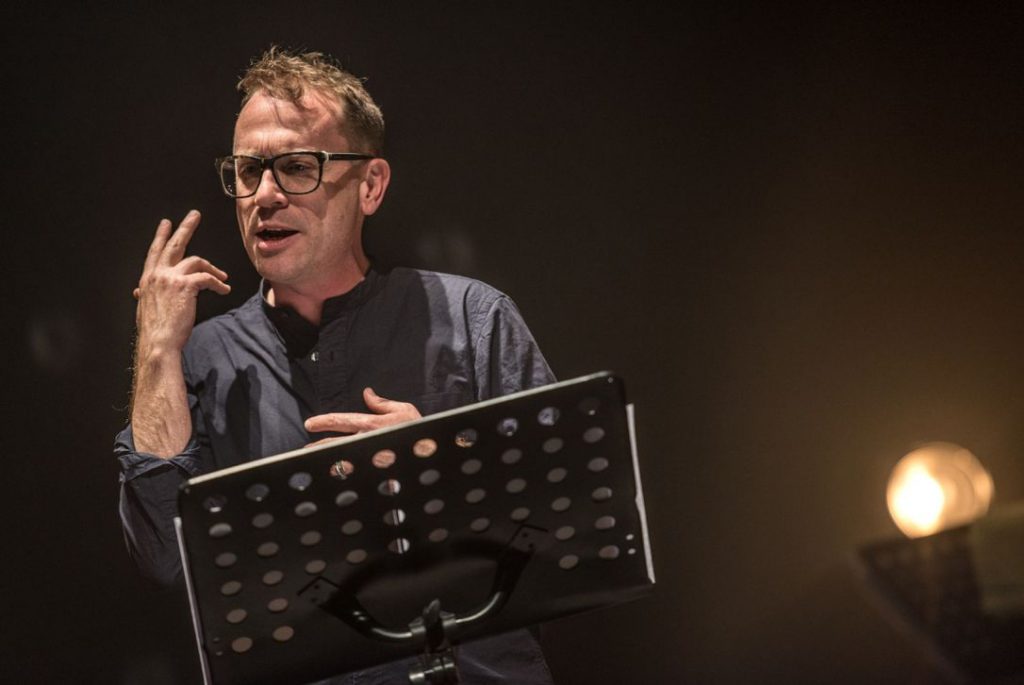True Crime is labyrinthine. The show, which played at the Centaur from Jan. 8-27, recounts indie-singer-turned-true-crime-writer Torquil Campbell’s real-life investigation into his con man doppelgänger, Christian Karl Gerhartsreiter. In 90 short minutes, Campbell whirls through his crimes, a series of kidnappings and murders, portraying Gerhartsreiter and his many aliases. Campbell also plays himself, chronicling his efforts to meet with Gerhartsreiter. Though the premise may seem overwhelming, Campbell captures his audience with a story replete with twists and turns befitting the popular true crime genre.
Campbell’s task of switching between the flamboyant Rockefeller, the sweet-talking Chichester, and the Bavarian Gerhartsreiter makes his job seems insurmountable. Undoubtedly, the exploration of a psychopath’s fractured identity is much more difficult than self-portrayal. Against all odds, however, Campbell manages to believably embody each part.
The unease Campbell creates during his monologues as Gerhartsreiter is particularly notable. He playfully rips through hyperactive speeches which often transform into terrifying aggression. The audience is left stunned in the wake of his explosive outbursts, and in the resulting silence, there is nothing to focus on but Gerhartsreiter’s menacing smile.
A much more subtle form of discomfort takes place during Campbell’s self-reflection. If Gerhartsreiter represents manipulative deception, Campbell bills himself as the relatable everyman. For much of the performance, Campbell stands centre stage, often slipping into improvised, informal speech, and breaks the fourth wall, setting up a friendly rapport with the audience. Similarly to his con man character, though, much of it is veneer. Campbell peels back the layers to unveil his own unpalatable qualities. Obsessive and reckless in pursuit of the truth, he lies to his family in order to keep contacting Gerhartsreiter, putting them all in danger. Near the end of the show, he betrays the audience’s trust too, implying that the entire tale is, in fact, fictitious. Deceptive and cunning, the similarities between Campbell and Gerhartsreiter run far deeper than their appearances.
While Campbell is the only actor, an equally-talented performer, musician Julian Brown, accompanies him onstage. Throughout the play, Brown sits upstage, equipped with a guitar and piano. Brown accompanies Campbell with a near-continuous stream of quiet riffs, twangs, and crescendos, and amidst a barebones set, he bolsters Campbell’s performance. With nothing much to engage the eyes, the technique is clever: It mimics the suspenseful ambiance true crime podcasts.
Ultimately, True Crime’s story is one of smoke and mirrors. Gerhartsreiter, whose mysteries are irresistible, is an elusive presence. Campbell, a reflection of Gerhartsreiter, comes to embody this enigmatic nature. He proves to be a master storyteller who spikes the same curiosity in his audience that initially inspired his play. Because Campbell’s show is based on a true story, there is no satisfying conclusion. When the mysteries are left unresolved, as they are for Campbell in real life, the audience is left compelled to seek the truth.








